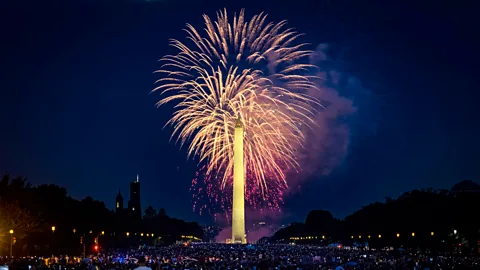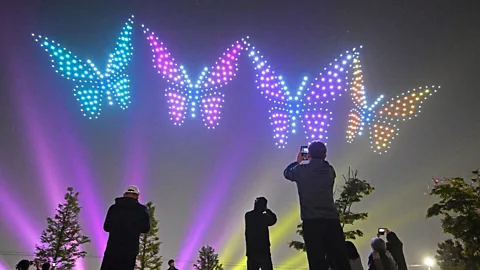Huge firework displays will mark 4 July in the US, but the nation's air quality will suffer
 Getty Images
Getty ImagesMillions of fireworks are set off each year to mark Independence Day in the US, causing air pollution to spike. Should you be worried?
Each year, Americans set off nearly 300 million lbs (136,000 tonnes) of fireworks – nearly one pound for every person living in America. In 2022, that figure jumped to more than 460 million pounds (209,000 tonnes) of fireworks. That's a lot of explosions and sparkles – but also a lot of smoke and waste, which may not only harm the planet, but also potentially the lungs of people nearby too.
Fireworks have been around for thousands of years, with many historians believing the first firecrackers originated in China in the 2nd Century BC. But we're now beginning to understand the scale of the impact they have on wildlife, the environment and human health.
Bad for our health?
While most attention about the dangers of fireworks focuses on injuries caused by burns and explosions, there are other far-reaching effects of these celebratory spectacles, especially when set off in large displays like the 4 July celebrations and New Year.
Certainly, firework-related injuries have increased in recent years, with men making up 70% of those injured, and 66% of injuries in the US happening in the weeks before and after July 4.
But Peter Brimblecombe, a professor of environmental sciences at the University of East Anglia, in the UK, and who lives in Waikiki, Hawaii, published a paper in 2023 analysing how fireworks can also contribute to particulate pollution in the air.
Fireworks generate large amounts of smoke, which can have an often visibly negative impact on air quality, but they also release other pollutants that are harder to see.
In some areas, the concentration of fine particulate pollution known as PM2.5 can be between 1.5 and 10 times higher than normal on the night of 4 July and the following day, according to one study of air quality in California in 2019 and 2020. These fine soot particles have been linked to a range of health problems including asthma, heart disease and low birth weight.
Another study of 315 sites across the US in 2015 showed that PM2.5 concentrations were on average 42% higher nationally during the 4 July holiday. The worst affected areas – those that were closest to large firework displays – saw the PM2.5 concentration nearly quadruple. But the pollution is usually short-lived and tends to diminish by noon the following day.
"Definitely, pollutant loads increase during the events," says Brimblecombe. "Poor air quality and the associated health risks have been part of New Year's Eve on Oahu [in Hawaii] for many years. And it remains a problem that continues to draw attention."
 Getty Images
Getty ImagesIn his own study, Brimblecombe found a "sharp rise" in the PM2.5 concentration during firework celebrations.
Fireworks also release a large amount of other air pollutants, particularly sulphur dioxide, carbon dioxide and carbon monoxide alongside particulate matter. Heavy metals, which give fireworks their bright colours, are also often toxic and tests in mice have shown particulate pollution containing these can be harmful. One recent study of air pollution in northern Utah by researchers at Brigham Young University in Provo, Utah, found that concentrations of metals such as copper, potassium, barium, chromium, vanadium and strontium spiked during the Independence Day holidays due to smoke from fireworks.
Individuals exposed to high levels of air pollutants have shown increased prevalence of chronic cough, phlegm and breathlessness – and are therefore at an increased risk of developing asthma, lung cancer, and other respiratory diseases. But there isn't necessarily a direct link between fireworks and long-term health impacts; although pyrotechnicians may be exposed to these health issues over the long term, most effects on audiences from fireworks are short-term, explains Brimblecombe.
"The link to health is harder to make, but I think it is more the workers than the general public that suffer," he says. "However, there is some evidence from Iceland that asthma attacks increased, but the statistics are poor as few people live in Iceland.
"Those with respiratory exposure may be affected by short high-concentration episodes," he adds. "And staying upwind of the displays could limit [this] exposure."
Some scientists have estimated that several hundred million people globally are exposed to firework smoke every year, although it is hard to say how accurate that figure really is.
One paper studying how fireworks affect respiratory health noted the need for more research, particularly into how fireworks impact those with asthma and other respiratory diseases. The researchers found that individuals suffering with respiratory conditions should "avoid heavy exposure".
The report added that children are particularly susceptible to the harmful effects of ambient air exposure.
Impact on the planet
Fireworks can also trigger wildfires that lead to far longer lasting and widespread air pollution. One analysis of wildfires on federal land in the US over a 37-year period from 1980 found that 11,294 of nearly 600,000 fires over that period could be attributed to fireworks. Two thirds of these occurred in the two-week period around 4 July.
Large wildfires can send pollution high into the atmosphere, causing it to spread over thousands of miles, during which time it can become more toxic.
 Getty Images
Getty ImagesBut fireworks also generate other waste that lasts far longer once the dazzling explosions fade and the smoke clears.
One study by the US Geological Survey and National Park Service found water samples taken from around Mount Rushmore between 2011-2015 showed elevated levels of perchlorate, which is used as a propellent in fireworks, in the areas where firework displays had taken place on Independence Days between 1998-2009. It also found elevated levels of the chemical in the soil where the fireworks were launched and where rocket debris landed. Another study from 2007 of a lake in Ada, Oklahoma, showed perchlorate levels rose following 4 July fireworks displays by up to 1,028 times the levels seen in the preceding days. It then took 20-80 days for the contamination to return to background levels.
There are concerns that this contamination can find its way into drinking water, where high levels of perchlorate can interfere with human thyroid function. The Environmental Protection Agency is now funding a study to assess just how much perchlorate from fireworks gets into the lakes, rivers and streams around the US.
But there are other problems that stem from the physical debris left behind by fireworks displays.
"Research on plastic pollution from fireworks is certainly gathering momentum," says Elizabeth Westhead, a bioscientist at the University of East London, UK. Westhead co-authored a study on microplastics levels in the River Thames in London during the New Year period. "[There's] growing evidence about its environmental impact," she says.
Westhead and her colleagues studied a stretch of the River Thames near Westminster – where the annual New Year fireworks are held – and found microplastics were "significantly higher" in the area following the dramatic fireworks in 2020. The study found microplastics increased by more than 1,000% over a 24-hour period.
"This short-term high influx of microplastics from fireworks will have detrimental impact on the ecology of the river and neighbouring waterways," says the study's lead author Ria Devereux, a sustainability researcher at the University of East London. "I was curious, especially as I didn't come across any literature on microplastics from fireworks. I expected some microplastics, but nowhere near the amount that I found.
"I think we were all in shock that so many microplastics entered the water system from a 15-minute firework event."
The study is significant, Devereux explains, because microplastics and polymer chemicals can be taken up by aquatic and marine animals, making their way into the food chain.
But getting people to pay attention to the plastic pollution caused by fireworks may take some time, concedes Westhead. "It will take even more time and much more work to influence public opinion on a very popular tradition," she says.
 Getty Images
Getty ImagesDistressed wildlife
It's a well-known fact that dogs are scared of fireworks. But studies have shown the devastating impact they can have on birds too.
A study tracking Arctic geese in Europe found that on one New Year's Eve the birds suddenly left their sleeping sites and flew to remote areas – up to 500km (311 miles) without rest. And the impacts lasted long after New Year's Eve. The birds never returned to their original sleeping sites. In one extreme case, hundreds of birds, primarily starlings, were found dead on the streets of Rome after a 2021 New Year's Eve firework event. In 2011, around 5,000 dead blackbirds fell from the sky on one single night in a small town in Arkansas, after being frightened out of their nighttime roosting sites and flying into trees and houses. Wildlife officials blamed the deaths on fireworks.
The annual timing of some large-scale firework events, such as July 4 and New Year's Eve, coincides with reproductive and migratory wildlife behaviour, one study noted, and so may have long-term population effects on the animals.
A more sustainable option
Environmentally friendly fireworks do exist – they have a clean-burning nitrogen-based fuel which create little smoke. There are also attempts to find alternatives to the harmful heavy metals without losing the brightly coloured sparks that make fireworks so appealing. "Quite a lot of emphasis at present on removing heavy metals that have ecosystem impacts has led to less polluting fireworks," says Brimblecombe.
But, they're still loud.
Laser shows and drones are just some of alternatives that have been used – they're reusable, have no emissions, and they're quiet. Drones are not without their drawbacks, though – they too disturb wildlife.
As researchers on one study on the impacts of fireworks on urban air quality summarised: "It is up to the local communities involved to decide in a balanced manner whether this form of amusement is worth the risky atmospheric cocktail it generates."
--
For essential climate news and hopeful developments to your inbox, sign up to the Future Earth newsletter, while The Essential List delivers a handpicked selection of features and insights twice a week.
